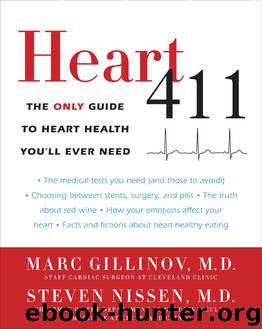Heart 411 by Marc Gillinov M.D

Author:Marc Gillinov, M.D. [Gillinov, Marc]
Language: eng
Format: epub
ISBN: 978-0-307-71992-8
Publisher: Potter/TenSpeed/Harmony
Published: 2012-01-30T16:00:00+00:00
Aspirin in Primary Prevention
Individuals are considered primary prevention patients if they have risk factors for heart disease, such as high cholesterol or hypertension, but have not yet suffered an event such as heart attack or stroke. The use of aspirin in these patients is more controversial. A large meta-analysis of primary prevention patients showed that aspirin did not reduce the risk of death or stroke, but it did result in a 12 percent reduction in the risk of a serious event such as heart attack. This statistic sounds favorable, but there is a problem.
Among primary prevention patients, the absolute event rates were very low, with only about 1 in 200 people experiencing a cardiovascular event each year; this compares to an incidence of 1 in 15 for some high-risk secondary prevention patients. These numbers mean that you would need to treat more than 1,000 primary prevention patients for a year to prevent a single cardiovascular event.
If you are a primary prevention patient (no known heart disease, no history of stroke) you might ask, “Why not take aspirin anyway, even if the benefit is small? After all, we all know that aspirin is safe, right?” Not so fast. Aspirin, like all drugs, has risks. In the primary prevention meta-analysis, the risk of a hemorrhagic stroke (bleeding into the brain) was increased by 32 percent, although the actual number of events was very small, just 1 in 250 patients per year. In primary prevention patients, the risk of serious bleeding not involving the brain was also increased, by about 50 percent, with an absolute risk of about 1 in 1,000 annually.
We can combine all of these findings into a risk-benefit analysis for aspirin in primary prevention patients. For every 10,000 patients treated for one year, there would be 6 fewer major coronary events and 2 fewer strokes due to blood clots, but at the cost of 1 additional stroke due to bleeding into the brain and 3 other episodes of serious bleeding. Based upon these observations, aspirin is not for everyone; we reserve it for primary prevention patients with the highest risk of a coronary event, such as smokers or certain diabetics who have other risk factors such as high blood pressure.
Let’s compare these figures with similar calculations for secondary prevention patients. In patients with preexisting coronary disease, for every 10,000 patients treated for one year, there would be about 100 fewer major coronary events, 46 fewer strokes of all types, and 29 fewer deaths. The number of serious bleeding episodes caused by aspirin in these secondary prevention patients is about 5 patients per 10,000. Obviously, the balance of benefit versus risk tilts strongly in favor of aspirin for patients who have already suffered a cardiovascular event. In fact, the higher the risk, the greater the benefit. For these patients, we do recommend a baby aspirin a day.
Download
This site does not store any files on its server. We only index and link to content provided by other sites. Please contact the content providers to delete copyright contents if any and email us, we'll remove relevant links or contents immediately.
Men In Love by Nancy Friday(5157)
Everything Happens for a Reason by Kate Bowler(4679)
The Immortal Life of Henrietta Lacks by Rebecca Skloot(4526)
Why We Sleep by Matthew Walker(4361)
The Sports Rules Book by Human Kinetics(4294)
Not a Diet Book by James Smith(3336)
The Emperor of All Maladies: A Biography of Cancer by Siddhartha Mukherjee(3068)
Sapiens and Homo Deus by Yuval Noah Harari(2987)
Day by Elie Wiesel(2720)
Angels in America by Tony Kushner(2596)
A Burst of Light by Audre Lorde(2546)
Endless Forms Most Beautiful by Sean B. Carroll(2431)
Hashimoto's Protocol by Izabella Wentz PharmD(2331)
Dirty Genes by Ben Lynch(2272)
Reservoir 13 by Jon McGregor(2242)
Wonder by R J Palacio(2140)
And the Band Played On by Randy Shilts(2129)
The Immune System Recovery Plan by Susan Blum(2030)
Stretching to Stay Young by Jessica Matthews(2001)
